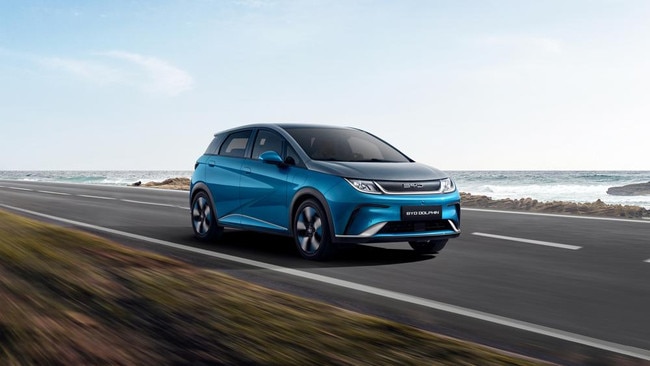One major hurdle continues to deter EV buyers, but Chinese EVs may change that
Recent research reveals a number of obstacles hindering EV adoption with one standout hurdle, but is this about to change as Chinese EVs enter the Australian market?
Technology
Don't miss out on the headlines from Technology. Followed categories will be added to My News.
Electric vehicles (EVs) are a hot topic but it’s evident buyers are still hesitant to make the change.
Research from insurance comparison site Compare the Market reveals significant barriers preventing widespread EV adoption among everyday consumers.
The primary obstacle is the purchase price.
Nearly three in five respondents (57.8 per cent) cited the cost to purchase an EV as a significant deterrent.
However, the market is on the verge of a shake-up.
Corporate Affairs Manager at Cox Automotive Australia, Mike Costello, explained that EVs have historically been more expensive but it’s “changing rapidly”.
“In fact, the long-desired cost parity already exists in particular on emerging Chinese products,” he said.
Costello said there are a handful of “urban friendly” EV options.

“EV cars such as the MG 4 and BYD Dolphin cost under $40,000, which is what a mid-spec Toyota Corolla costs these days,
“But we ought not forget the recent price cuts from market leader Tesla, which has cut the [recommended retail price] of the Model 3 substantially in recent months,” he said.
Costello emphasised the importance of state-specific subsidies and novated lease options, which can significantly reduce the overall cost of owning an EV.
“When it comes to EVs it’s important to consider cost savings that can be had from the State-specific subsidies being offered, while those who are able to get a novated lease through their employer can save many thousands by avoiding fringe-benefits tax and GST on EVs too.”
A lack of choice is another hangup.
“This will probably change but right now the reality is, there’s not an EV for everyone,” Costello said.
“The market is growing rapidly, with 200,000 new EVs sold here since 2022 and the first wave due to enter the used market soon.”
Budget-conscious consumers can also consider second-hand EVs.
Despite the high prices, EVs can be cheaper to operate annually compared to petrol cars, as Compare the Market’s Executive General Manager of General Insurance and car insurance expert, Adrian Taylor explained.
“We’re all feeling the pinch in this cost-of-living crisis, so it’s no wonder that people are not considering buying EVs when the general entry-level price range for these vehicles is around $50,000, while for fuel-based or ICE vehicles, it can be as low as $30,000 or even lower if you’re looking for a small car,” he said.
The price far outweighed other issues, with only 9 per cent of participants reporting no deterrents to buying an EV.
Beyond the initial cost, potential buyers are also wary of battery life and replacement costs.
Costello explained that significant advancements in battery technology and management systems are helping to alleviate these worries.
“All EV batteries are covered by eight years of warranty against degradation beyond the norm, which is roughly 2 per cent per annum at worst.
There are now a lot of decade-old EVs here and overseas showing relatively minimal battery wear,” he said.
Other areas of concern for consumers are the availability of local charging stations, the time required to charge the vehicle, and the overall driving range.
Costello highlights significant advancements with companies like Evie and ChargeFox expanding their networks with the help of taxpayer funding but he emphasised the need for more widespread public charging stations.
“Destination and public charging needs to become more ubiquitous too – leading the charge should be petrol companies which have service stations everywhere, and major retailers with parking,” he said.

Over a quarter of respondents also expressed concerns about the cost of insuring EVs.
Compare the Market’s previous research indicates that car insurance for EVs tends to be higher than for comparable internal combustion engine (ICE) vehicles, further complicating the decision for potential buyers.
Taylor explained that we’re seeing higher insurance costs for EVs because parts may be harder to source and repair as well as the current lack of expertise to service, but he expects this will change.
“But with the advances that the automotive industry is taking to catch up to the need for specialist mechanics, we should see insurance prices drop in the near future,” he said.
To mitigate these costs, Taylor encourages consumers to compare their options, whether it’s the cost of running a new EV versus their current car or exploring ways to reduce car insurance expenses.
Government incentives also aim to alleviate the financial burden for prospective EV buyers.
These incentives include exemptions from the fringe benefit tax for eligible low or zero-emission vehicles nationwide, rebates of up to $6,000 for new zero-emission vehicles in Queensland, and up to $3,500 in Western Australia, along with various stamp-duty and registration exemptions across the country.
Australians are advised to check with their state governments for available rebates.
Costello said while the rebates like the $6,000 offered in Queensland help boost sales, he suggested other measures might be more effective.
“I believe the best use of public incentives is to fund charging and remove taxes, rather than direct rebates,” he said.
Originally published as One major hurdle continues to deter EV buyers, but Chinese EVs may change that




